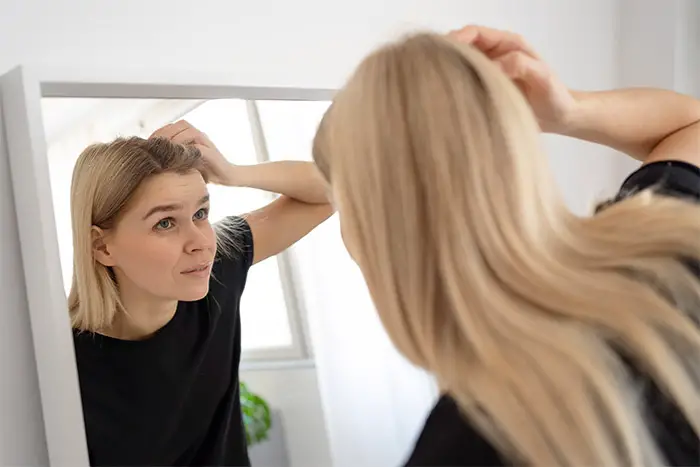Many of us spend considerable time and effort maintaining our hair, yet overlook the foundation from which it grows – our scalp. One of the frequently asked questions regarding scalp health is, “Why is my scalp pink?”
This article will delve into the reasons behind the pink hue and offer insights into when it might be cause for concern, and what remedies exist.

In this article:
- The Vital Role of Scalp Health in Hair Care
- Exploring the Varieties of Scalp Colour
- Is Your Pink Scalp Normal and Healthy?
- Unveiling the Causes of a Pink Scalp
- Linking Pink Scalp with Thinning Hair and Hair Loss
- Should You Worry About a Pink Scalp?
- Treatments and Remedies for Pink Scalp
- Caring for Your Scalp Post-Procedure
- FAQs
The Vital Role of Scalp Health in Hair Care
The scalp is more than just the bedrock for hair; it’s a direct reflection of our overall hair health. A scalp in good condition promotes healthy hair growth, ensures the hair is strong and lustrous, and can even influence hair thickness.
Essential aspects of scalp health include cleanliness, adequate hydration, and healthy blood circulation:
1. Cleanliness: Regularly washing your scalp is crucial to prevent the build-up of oil and products, which can potentially clog hair follicles and subsequently lead to hair thinning. Additionally, maintaining cleanliness minimizes harmful microbial growth, reduces the risk of dandruff, and protects the scalp from irritations caused by dirt and pollutants.
2. Hydration: A healthy scalp keeps your hair safe and holds in moisture. Keeping it well-hydrated stops it from getting flaky and itchy, and helps your hair stay healthy. When your scalp has enough moisture, your hair won’t get dry or brittle.
3. Blood Circulation: Good blood flow to the scalp brings important nutrients that help hair grow healthy and strong. It also helps get rid of waste, keeping the scalp clean. Doing things like scalp massages can make the blood flow better and help hair grow faster.
Exploring the Varieties of Scalp Colour
Your scalp color can be different based on your genes and where your ancestors are from. There are two main types of melanin that affect the color: eumelanin (black/brown) and pheomelanin (red/yellow). Everyone has a mix of these, but in different amounts.
- African and African-Caribbean People: Often have dark scalps because they have more eumelanin.
- Caucasians: Might have a lighter or pinkish scalp due to a mix of eumelanin and pheomelanin.
- Asians: Usually have a yellowish or light brown scalp because they have a lot of eumelanin.
- Indigenous Peoples: Can have a mix of colors or unique colors based on their genes.
Why is Understanding Melanin Important?
Knowing about melanin and scalp color is key to spotting any unusual changes in your scalp, which could signal health issues. This knowledge also guides you in choosing the right hair treatments and dyes, ensuring you take the best care of your scalp and hair.
Is Your Pink Scalp Normal and Healthy?
After exploring the various natural hues of the scalp across different ethnicities, you might wonder about the specifics of pink scalp coloration. Is it a standard shade, or should it be a cause for concern?
A pink scalp can indeed be normal and healthy, particularly if it isn’t associated with other symptoms like itching or pain. The pink hue might simply result from a combination of melanin types or the level of blood flow to the scalp.
However, it’s important to remember: if your usually white scalp suddenly turns pink, that’s not normal. This unexpected change might be because of sunburn, an allergic reaction, or different skin issues.
A pinkish hue to the scalp is perfectly normal for many individuals, especially those with lighter skin tones. It’s crucial to understand that ‘healthy’ can look different from person to person. Some may naturally have a pinkish undertone without experiencing any scalp or hair issues.
Always ensure to check the following signs of a healthy scalp:
- No Excessive Dryness or Oiliness: A balanced scalp neither feels too dry nor too greasy.
- Minimal to No Flaking: Little to no dandruff or other forms of flaking.
- Free from Itchiness: No urge to scratch.
- Even Tone: Consistent color without dark spots or discoloration.
- Hair Growth: Hair grows evenly, without excessive shedding or thinning.
- No Irritation: Absence of redness, tenderness, or inflammation.
If you’re worried about your scalp color or if you notice any changes or problems, it’s always a good idea to check with a healthcare professional.
Unveiling the Causes of a Pink Scalp
While a pinkish hue is perfectly normal for many of us, it’s true that in some cases, it might hint at an underlying issue. But don’t worry, we’re here to explore what these might be together. Here are a few signs that may indicate that your pink scalp may be a bad sign:
- Inflammation: A sudden change to a redder or pinker hue, especially when accompanied by itching or pain, could indicate inflammation.
- Sunburn: Extended exposure to UV rays can lead to sunburn, turning the scalp pink or even red.
- Allergic Reactions: Some people might develop allergies to hair products, causing the scalp to turn pink and become itchy or inflamed.
- Skin Conditions: Seborrheic dermatitis, scalp psoriasis, or other skin conditions can lead to a pink or reddened scalp.
- Infections: Fungal or bacterial infections might cause redness or pink patches.
- Medical Conditions: Some more severe medical conditions, like lupus or scalp melanoma, can manifest as pink or red patches on the scalp.
In these cases, a pink scalp might be a symptom rather than a natural coloration. It’s crucial to observe any accompanying symptoms and consult with a dermatologist or trichologist to get a clear understanding of one’s scalp health.
Linking Pink Scalp with Thinning Hair and Hair Loss
Seeing a pink scalp along with thinning hair or hair loss can be a bit worrying. This combination might suggest there are issues stopping hair from growing healthily.
A pink scalp might show there’s more blood flow or swelling, which can be linked to conditions that also make hair thin or fall out. Here are a few possible reasons:
- Chronic Inflammation: Ongoing swelling can hurt hair follicles, which might lead to hair thinning or loss. A pink scalp might show this swelling is happening.
- Scalp Conditions: Some scalp problems, like dermatitis or psoriasis, might cause both a pink color and impact hair growth by hurting the hair follicle.
- Allergic Reactions: Being allergic to hair care products or things in the environment might cause a pink scalp and, sometimes, affect hair health and growth.
- Hormonal Changes: Sometimes, changes in hormones can lead to hair loss and may also affect the skin, including the scalp, by changing blood flow or skin health.
Understanding the exact cause behind a pink scalp along with thinning hair or hair loss is key to tackling the issue effectively. It’s always a good idea to talk to a healthcare professional or a skin doctor to find out the root causes and figure out the best way to deal with them.
Should You Worry About a Pink Scalp?
So, is a pink scalp bad? Not always. A light pink scalp is normal for many people. But if the pink is really bright, if there are spots, or if it’s itchy or painful, it might be a sign of a problem.
One serious concern to be mindful of is melanoma, a type of skin cancer, which can sometimes appear on the scalp as a firm pink or red lump. Melanomas on the scalp can be especially dangerous and are often more deadly than melanomas on other parts of the body. This might be because they’re harder to find unless you’re actively looking for them. Also, the scalp has lots of blood vessels, which might make it easier for the melanoma to spread.
It’s also important to point out that melanoma isn’t the only reason for concern when it comes to a pink scalp. Other issues like infections, sunburn, or different skin conditions can also make the scalp turn pink and should be checked by a doctor, especially if you notice other symptoms like flaking, pain, or hair loss.
Treatments and Remedies for Pink Scalp
Fixing a pink scalp mostly depends on why it’s pink in the first place. Here are some ways to help a pink scalp:
Scalp Cleansing Oils
Using oils that are good for the scalp can help calm irritation, fight dryness, and keep the scalp healthy. Here are some oils and how they help:
- Tea Tree Oil: Known for its antiseptic properties, it helps manage dandruff and reduces inflammation.
- Lavender Oil: Fights against microbial growth and has a soothing scent.
- Jojoba and Coconut Oils: Provide moisture without clogging pores.
- Peppermint Oil: Offers a cooling effect and encourages blood flow.
- Rosemary Oil: Supports hair root strength and promotes growth.
- Chamomile Oil: Renowned for its calming properties.
- Argan Oil: Often referred to as ‘liquid gold’, it moisturizes and protects the scalp.
- Castor Oil: Can help with many scalp problems.
- Olive Oil: Conditions and moisturizes the scalp, providing dandruff protection and is rich in antioxidants.
Over-the-Counter Creams
For mild inflammation or sunburn, creams that you can buy without a prescription might be helpful.
Seek Medical Attention
For more severe cases or persistent issues, it’s crucial to consult with a healthcare professional.
Other Tips
- Gentle Shampoo: Use a shampoo that is gentle and made for sensitive scalps.
- Avoid Hot Water: Don’t use very hot water when washing your hair because it can make your scalp more irritated.
- Wear a Hat: Protect your scalp from the sun to avoid sunburn.
- Avoid Harsh Chemicals: Try not to use hair products with strong chemicals, like bleach, as they can irritate the scalp.
Remember, it’s always a good idea to talk to a professional about your scalp, especially if you’re trying new treatments or if the pink color doesn’t go away.
Caring for Your Scalp Post-Procedure
Taking care of a pink scalp after procedures like dyeing, bleaching, or hair transplants involves both immediate care and ongoing maintenance to soothe and heal the affected area. Here are steps you can take:
Immediate Aftercare:
- Cold Compress: Apply a cold compress to soothe the scalp immediately after the procedure. This will help reduce inflammation and redness.
- Avoid Hot Water: When washing your hair post-procedure, use lukewarm or cool water instead of hot. Hot water can further irritate the scalp.
- Stay Out of the Sun: Protect your scalp from direct sunlight to prevent additional redness and irritation. If you need to be outside, wear a hat or use an umbrella.
Use Gentle Products:
- Sulfate-Free Shampoos: Choose mild shampoos without sulfates, as they are less likely to irritate the scalp.
- Natural Conditioners: Opt for conditioners with soothing natural ingredients like aloe vera, chamomile or oat extract.
- Avoid Harsh Chemicals: Stay away from hair products with alcohol, parabens, or other potentially irritating chemicals.
Soothing Treatments:
- Aloe Vera Gel: This natural remedy can be applied directly to the scalp to provide a cooling sensation and reduce redness.
- Oatmeal Mask: Ground oatmeal mixed with water can be applied as a mask to the scalp. Oatmeal has natural anti-inflammatory properties that can help soothe irritation.
Natural Oils:
- Coconut Oil: Known for its excellent moisturizing abilities, coconut oil can soothe dryness and irritation on the scalp while also providing antimicrobial benefits to protect against bacteria and fungi.
- Jojoba Oil: This oil closely mimics the skin’s natural sebum and can moisturize without clogging pores.
Avoid Further Procedures Temporarily:
Give your scalp some time to heal before undergoing further procedures or treatments. Repeated exposure can compound irritation and prolong recovery.
Consultation:
If you had a hair transplant and are experiencing prolonged redness, it’s essential to consult with your surgeon to ensure everything is healing as expected.
For dyeing or bleaching, if redness persists or if you experience extreme discomfort, consider consulting a dermatologist or trichologist.
FAQs
Why is my scalp pink and itchy?
A pink and itchy scalp could be due to various reasons such as irritation, allergic reactions to hair products, sunburn, or underlying skin conditions like dermatitis or psoriasis. It’s advisable to consult with a healthcare professional for an accurate diagnosis and appropriate treatment.
Why is my scalp pink and tender?
A pink and tender scalp could be a sign of irritation, sunburn, or a reaction to a hair product. It’s a good idea to consult a healthcare professional to get to the root of the issue.
How can I hide pink scalp with white hair?
To hide a pink scalp with white hair, you might consider using a tinted dry shampoo or hair powder that matches your hair color to camouflage the scalp. Wearing hairstyles that cover more of the scalp, like a side part or waves, can also help disguise the pinkness.
If it’s appropriate, hats or headscarves can be stylish and protective options too. Always ensure to address the cause of the pink scalp with a professional.
Note to Readers
This article is intended for informational purposes only and does not substitute professional medical advice, diagnosis, or treatment. Always seek the advice of your physician or another qualified health provider with any questions you may have regarding a medical condition.

Petra Nakashian (previously Kravos) is a dedicated natural health and beauty blogger, driven by the loss of her parents to cancer, which led her to meticulously research beauty product ingredients. With over 10 years of experience, her in-depth knowledge has made her a trusted expert in the field. Founder of Be Healthy Now and Green Beauty Talk, Petra recently expanded her expertise with Beauty Insights Hub, exploring a wider range of beauty treatments. Committed to transparency and honesty, her work is a vital resource for navigating the complex world of beauty.

